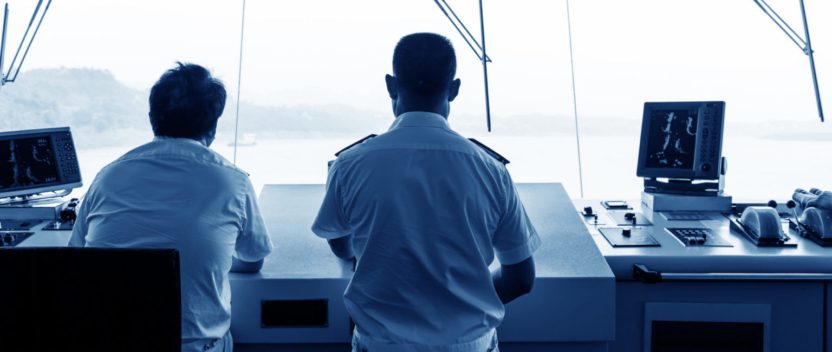From shore to ship: a new frontier?
“Why not give your chief cook an iPad?” Director, Group Strategy, HR & Support for Thome Ship Management Michael Elwert asked at the close of the recent Sea-Asia conference in Singapore.
He was relating the bemused response he received when suggesting to an owner that they give their staff tools that go beyond the essentials of their day to day job function.
Perhaps the owner thought the iPads would become hi-tech chopping boards, but Elwert was making a serious point about productivity and cost control. “We give iPads to children,” he continued. “Don’t we want our crews to work smarter?” he asked.
The question was more than a mere rhetorical flourish. It illustrates the conflict at the nexus of shipping and technology: do only what is practical or imagine what might be possible and take a step forward?
In the post-financial crisis era, shipping has low ambitions, Or rather, because it has survived for thousands of years by doing a simple thing well, the reasons for change have to be critical when earnings are so low and costs high.
And from a cynic’s viewpoint, the technology revolution sweeping over many sectors of business – having already utterly altered consumer behaviour – could be seen as something that ‘isn’t happening to shipping’. The pressing need is to stabilise profitability, manage costs and in some cases, make the business sustainable. These things, so the thinking goes, are not related to the acquisition of new technology.
As Vroon Group Commercial Director Herman Marks put it at the recent ShipServ Smart Procurement event, “We don’t connect people or things, we connect markets, we are responsible for making sure that trade happens”.
Invited to imagine shipping in 2030, Marks pointed out that for an owner such as Vroon, with a large diverse fleet and more than a century of history, a 15-year time horizon is not particularly long. His assets, many of which are subject to a fleet renewal programme have a 25-30 year lifecycle.
To some extent this signals more of the same rather than a revolution. There are changes expected, but not enough to make the average software developer salivate. An increase in automation, the greater use of electrical equipment and the monitoring needed to regulate and manage power production inevitably means increased access to shore and vice versa.
“We can already monitor engine performance remotely and tune the settings from shore,” said Marks. “As more equipment becomes connected to manufacturers for maintenance, a lot more data is being captured and transferred to the office.”
Maintenance concepts have changed over time, moving to condition-based systems that can alert for faults and order spare parts for delivery in the next port, something he expects to see more of in the next few years.
He also sees pressure of consolidation on suppliers to newbuilding projects, with vendors under pressure to become more integrated as a way to remain on the preferred supplier lists.
“The yards are becoming integrators of equipment packages, especially on technical ships like gas carriers, and like to buy all the equipment as one package. We see that more and more and it is happening quite fast.”
The concept of a main engine ‘as a service’ might be some distance away, but the direction of travel is set. Caterpillar Marine Product Support Consultant Gavin Menzies said his company had produced a service and support package which puts them much closer to a collaborative model than being a pure vendor.
“Using a supplier maintenance agreement with an OEM means you get reliability. We can transfer OEM spares through a supplier and be responsible for maintaining all major items that aren’t covered by class,” he said. “For overhauls the items can come back to the OEM themselves.”
To judge from the comments of other owners at the event, the desire to increase efficiency and cut costs is already driving a trend towards more autonomy for ships and their crews in the purchasing process. With fewer people onboard, it makes sense for vessel and supplier to communicate directly, with the office keeping a watching brief.
CMA Ships’ Julien Garro warned that shipowners with large fleets still viewed connectivity as a problem cost, but this had not stopped CMA rolling out a programme that would let vessels deal direct with suppliers, buying according to a price list negotiated once or twice a year. “For consumables this is very efficient, though not for spare parts. We aim to get a 10% saving as a result.”
Utkilen does the same, as Purchasing Manager Knut Ove Thuland Hansen explained, with Chief Engineers able to deal direct with suppliers and merely copy in the office. “We started with food ordering and budgeting and they have an interest in that but we have to trust them,” said Hansen. “They are purchasers, the same as we are.”
By the second year of the programme he expects to have high quality data on what the vessels are buying as well as making some savings. “Instead of increasing the number of suppliers, we can use fewer and make the ship responsible for their own consumables so we can spend more time on higher value spares.”
Ultraship has a similar model and Head of Procurement Jesper Alex Larsen says the company gives the vessels a budget and leaves them to it. For spare parts he is prepared to adopt an ultra-lean approach and rely on planned maintenance.
“The target is to have almost no spares on board, because often you have to maintain them. Instead, get a better relationship with your supplier and let them hold the stock. With some suppliers we have agreements that allow us to jump the queue if the urgency demands it,” he said.
The key to successful empowerment might ironically, mean keeping a level of oversight and control but it also requires adopting a data-centric approach to the business. Doing so enables companies to streamline in other areas too as officers can move from ship to ship and instantly recognise procedures. And owners are keen to devolve more responsibility to their partners in future.
The transfer of an increased level of purchasing responsibility from office to ship is a welcome trend to ShipServ CEO and Founder Paul Ostergaard. The need for some control and intervention does not mean there should be constraints on the intelligence needed to make purchase decisions with supplier support, he says.
“We believe that a lot of the intelligence required already exists on the ship but often they lack access to the tools, the data and feedback from suppliers,” he said. “What we are aiming for is to make that information available in real time to all parts of the supply chain.”
“Once you can see what is available, which suppliers, under which contracts, which products and prices; once we can make that information available, every company will put the decision where the expertise is. In many cases that is onboard the ship. Once you have the data on purchases and suppliers you can put more and more in the hands of the crew. We are big fans of that vision.”
Ends


